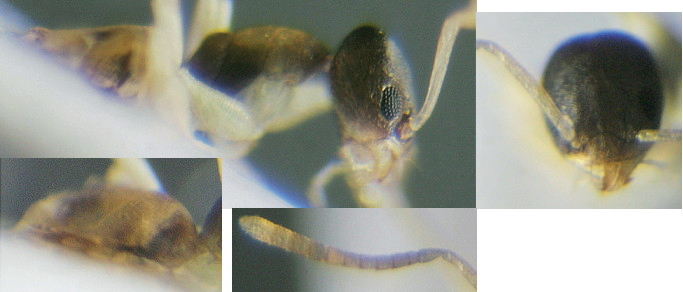SUBFAMILY DOLICHODERINAE - Genus Tapinoma Förster
| The Ants
of Egypt SUBFAMILY DOLICHODERINAE - Genus Tapinoma Förster |
Diagnostic Features - Eyes at or in front of the midlength of the head on the dorsal surface. Clypeus with or without the anterior margin emarginate. Mandibles with large apical two or three teeth, followed by a row of denticles. Palp formula, 6,4; and palpi long. Propodeum unarmed or rarely with a pair of blunt tubercles. Gaster in dorsal view with four visible tergites, the anal and associated orifices are ventral.
Foerster's (1850a) genus definition is at ![]() . Mayr (1855: 372) gave a genus description
and a key to separate European species, this is at
. Mayr (1855: 372) gave a genus description
and a key to separate European species, this is at ![]() .
Mayr (1861: 41) gave a genus description, this is at
.
Mayr (1861: 41) gave a genus description, this is at ![]() .
.
Separation of species
| 1 |  Anterior border of clypeus
entire; TL 1.5-1.75 mm; variably coloured but with significant pale
areas of alitrunk and gaster contrasting with the dark brown head,
appendages wholly pale yellowish. Anterior border of clypeus
entire; TL 1.5-1.75 mm; variably coloured but with significant pale
areas of alitrunk and gaster contrasting with the dark brown head,
appendages wholly pale yellowish. |
widespread tramp species - Tapinoma melanocephalum |
| -- | Anterior border of clypeus with medial notch |
2 |
| 2 |  TL 2.5-3.5 mm; black or
brownish black, often mandibles, antennae and most of legs dark brown,
tarsi yellowish; pubescence abundant, erect hairs sparse; wholly very
finely striato-punctate, quite shiny. The subspecies nigerrimum
is larger TL 3.5-4.0 mm, with antennae and legs wholly pale reddish in
the smallest individuals, although the pale sections are reduced in
larger specimens TL 2.5-3.5 mm; black or
brownish black, often mandibles, antennae and most of legs dark brown,
tarsi yellowish; pubescence abundant, erect hairs sparse; wholly very
finely striato-punctate, quite shiny. The subspecies nigerrimum
is larger TL 3.5-4.0 mm, with antennae and legs wholly pale reddish in
the smallest individuals, although the pale sections are reduced in
larger specimens |
Europe & Middle East - Tapinoma erraticum |
| -- |  Apparently somewhat larger; the
propodeum is lower with a shallow angle between the dorsum and
declivity; appendages almost entirely dark Apparently somewhat larger; the
propodeum is lower with a shallow angle between the dorsum and
declivity; appendages almost entirely dark |
Eastern Mediterranean & Middle East - Tapinoma simrothi |
|
©2005, 2006, 2009, 2015, 2019 - Brian
Taylor CBiol FRSB FRES 11, Grazingfield, Wilford, Nottingham, NG11 7FN, U.K. |
href="tapinoma.htm"